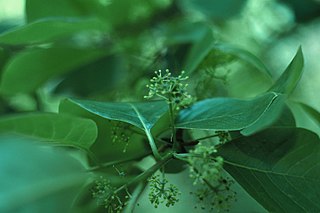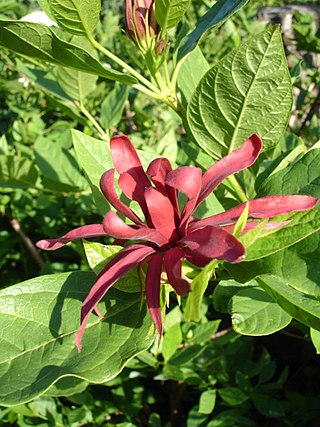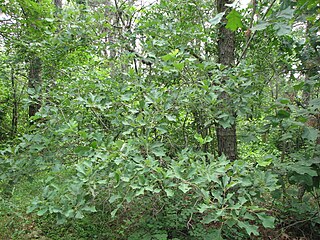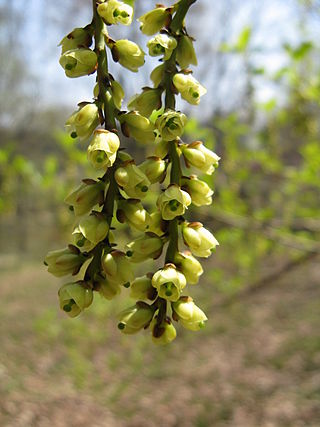
Tupelo, genus Nyssa, is a small genus of deciduous trees with alternate, simple leaves. It is sometimes included in the subfamily Nyssoideae of the dogwood family, Cornaceae, but is placed by other authorities in the family Nyssaceae. In the APG IV system, it is placed in Nyssaceae.

Jasmine is a genus of shrubs and vines in the olive family of Oleaceae. It contains around 200 species native to tropical and warm temperate regions of Eurasia, Africa, and Oceania. Jasmines are widely cultivated for the characteristic fragrance of their flowers. Additionally a number of unrelated species of plants or flowers contain the word "jasmine" in their common names.

Buddleja is a genus comprising over 140 species of flowering plants endemic to Asia, Africa, and the Americas. The generic name bestowed by Linnaeus posthumously honoured the Reverend Adam Buddle (1662–1715), an English botanist and rector, at the suggestion of Dr. William Houstoun. Houstoun sent the first plants to become known to science as buddleja to England from the Caribbean about 15 years after Buddle's death. Buddleja species, especially Buddleja davidii and interspecific hybrids, are commonly known as butterfly bushes and are frequently cultivated as garden shrubs. Buddleja davidii has become an invasive species in both Europe and North America.

Ziziphus is a genus of about 40 species of spiny shrubs and small trees in the buckthorn family, Rhamnaceae, distributed in the warm-temperate, subtropical and tropical regions of the world. The leaves are alternate, entire, with three prominent basal veins, and 2–7 cm (0.79–2.76 in) long; some species are deciduous, others evergreen. The flowers are small, inconspicuous yellow-green. The fruit is an edible drupe, yellow-brown, red, or black, globose or oblong, 1–5 cm (0.39–1.97 in) long, often very sweet and sugary, reminiscent of a date in texture and flavour.

Mahonia is a genus of approximately 70 species of evergreen shrubs and, rarely, small trees in the family Berberidaceae, native to eastern Asia, the Himalaya, North and Central America. They are closely related to the genus Berberis and botanists disagree on whether to recognize a separate Mahonia. Many botanists prefer to classify Mahonia as a part of Berberis because several species in both genera are able to hybridize, and because there are no consistent morphological differences between the two groups other than the leaf pinnation. However, recent DNA-based phylogenetic studies retain the two separate genera, by clarifying that unifoliolate-leaved Berberis s.s. is derived from within a paraphyletic group of shrubs bearing imparipinnate evergreen leaves, which are then divided into three genera: Mahonia, Alloberberis, and Moranothamnus ; a broadly-circumscribed Berberis would also be monophyletic.

Thespesia is a genus of 14 flowering shrubs and trees in the Hibiscus family, Malvaceae, although within the family they are more closely related to cotton plants (Gossypium). The genus is distributed from the South Pacific through Asia, Africa, and the Caribbean.

Myrica is a genus of about 35–50 species of small trees and shrubs in the family Myricaceae, order Fagales. The genus has a wide distribution, including Africa, Asia, Europe, North America and South America, and missing only from Australia. Some botanists split the genus into two genera on the basis of the catkin and fruit structure, restricting Myrica to a few species, and treating the others in Morella.

Gouania is a genus of flowering plants in the family Rhamnaceae. The 50 to 70 species it contains are native to tropical and subtropical regions of the world, including Africa, Madagascar, the Indian Ocean islands, southern Asia, the Americas and Hawaii. They are shrubs or lianas. A revision of the species in Madagascar and the other western Indian Ocean islands is in preparation, where the genus has an important centre of diversity. The work will recognise several new species.

Calycanthus, called sweetshrub, is a genus of flowering plants in the family Calycanthaceae. The genus includes two to four species depending on taxonomic interpretation; three are accepted by most 21st century sources.

Prunus subcordata, known by the common names Klamath plum, Oregon plum, Pacific plum and Sierra plum, is a member of the genus Prunus, native to the western United States, especially California and Oregon.

Plumeria rubra is a deciduous plant species belonging to the genus Plumeria. Originally native to Mexico, Central America, Colombia and Venezuela, it has been widely cultivated in subtropical and tropical climates worldwide and is a popular garden and park plant, as well as being used in temples and cemeteries. It grows as a spreading tree to 7–8 m (23–26 ft) high and wide, and is flushed with fragrant flowers of shades of pink, white and yellow over the summer and autumn.

Itea virginica, commonly known as Virginia willow or Virginia sweetspire, is a small North American flowering shrub that grows in low-lying woods and wetland margins. Virginia willow is a member of the Iteaceae family, and native to the southeast United States. Itea virginica has small flowers on pendulous racemes.

Ilex, or holly, is a genus of over 570 species of flowering plants in the family Aquifoliaceae, and the only living genus in that family. Ilex has the most species of any woody dioecious angiosperm genus. The species are evergreen or deciduous trees, shrubs, and climbers from tropics to temperate zones worldwide. The type species is Ilex aquifolium, the common European holly used in Christmas decorations and cards.

Quercus ilicifolia, commonly known as bear oak or scrub oak, is a small shrubby oak native to the Eastern United States and, less commonly, in southeastern Canada. Its range in the United States extends from Maine to North Carolina, with reports of a few populations north of the international frontier in Ontario. The name ilicifolia means "holly-leaved."

Iteaceae is a flowering plant family of trees and shrubs native to the eastern USA, southeastern Africa, and south and Southeastern Asia. Some older taxonomic systems place the genus Itea in the family Grossulariaceae. The APG III system of 2009 includes the former Pterostemonaceae in Iteaceae. Consequently, it now has two genera with a total of 18 known species.

Stachyurus is the only genus in the flowering plant family Stachyuraceae, native to the Himalayas and eastern Asia. They are deciduous shrubs or small trees with pendent racemes of 4-petalled flowers which appear on the bare branches before the leaves. The plants have leaves with serrate margins.

Hypericum sect. Adenosepalum is one of 36 sections in the genus Hypericum. Its type species is Hypericum montanum.
The anthophytes are a grouping of plant taxa bearing flower-like reproductive structures. They were formerly thought to be a clade comprising plants bearing flower-like structures. The group contained the angiosperms - the extant flowering plants, such as roses and grasses - as well as the Gnetales and the extinct Bennettitales.

Calycanthus chinensis, known as Chinese sweetshrub, is a species of flowering plant in the family Calycanthaceae, native to Southeast China. It was first given a valid scientific name in 1964. It is cultivated as an ornamental flowering shrub, and has been hybridized with two other species in the genus Calycanthus to combine its larger and broader tepalled flowers with their scented and more colourful ones.

Plantago virginica, common names hoary plantain and Virginia plantain, is a species of plant native to North America and introduced in Asia. It is listed as a special concern in Connecticut. The Kiowa use it to make garlands or wreaths for old men to wear around their heads during ceremonial dances as a symbol of health. It is commonly found within the continental United States in the majority of states along coastal areas and on roads, though has become an invasive species to eastern China after its introduction c. 1980. It is an annual plant, blooming around the month of May.


















